There are just so many types of sushi that you might wonder what to order. In this guide, I have photos, videos, and all of the popular types explained.
Sushi is known to be highly skilled and artistic Japanese cuisine, which has become very popular and common in western countries.
Today, it’s possible to walk into your local retail or grocery store and get a take-away sushi package that you can enjoy in the comfort of your home as you watch Netflix.
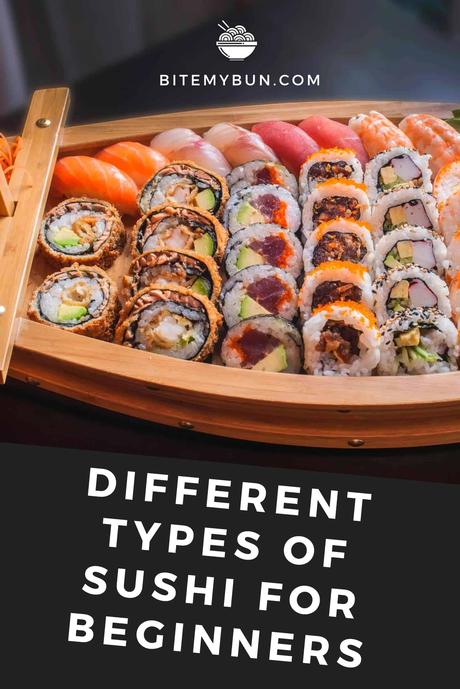
However, whether you are enjoying sushi from the comfort of your home or a five-star Japanese restaurant, you cannot deny that sushi is one of the famous Japanese delicacies and is very popular throughout the entire world.
In this post, I’ll walk you through the differences between Japanese and American sushi and we’ll take a look at the most popular types of sushi you can find.
What is sushi?
Sushi is a Japanese style of cuisine, they use vegetables, fish (cooked or raw), and then it is mixed with rice that has been seasoned using vinegar.
Most restaurants usually serve wasabi, soy sauce, and pickled ginger alongside this famous Japanese delicacy.
The sushi we enjoy today is a lot different from the sushi that was eaten several years ago.
Originally, sushi was a staple dish of various parts of Asia, and it was basically salted fish that was well-preserved in fermented rice.
Actually, the word “sushi” can be translated to “sour,” and this explains its fermented origins.
The original style of sushi was very popular in japan up to the end of the Edo Era, where it changed to Edomane Zushi—which is a bit closer to the sushi we enjoy eating today.
In fact, the sushi rolls with a Nori exterior was born in the middle of the 18th century. The Nori sheet was invented in that period and the sushi roll was born soon afterward. Read more about the evolution of sushi from the beginning.
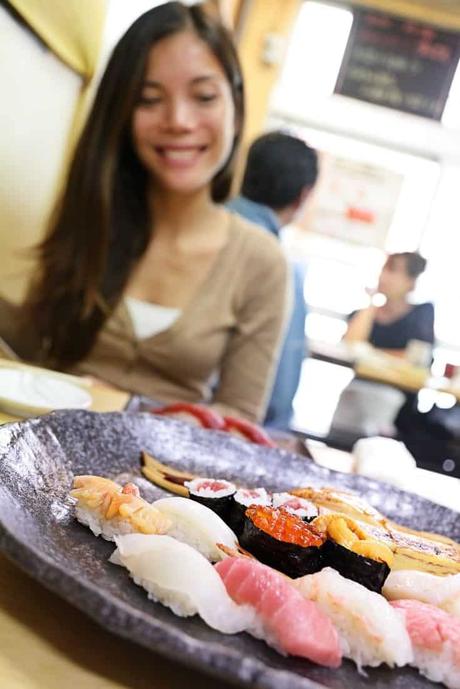
Traditional sushi was developed by Hanaya Yohei, and it was a bit larger than the original sushi, required fresh fish, didn’t take a lot of time in preparation, and it was to be eaten with bare hands.
Read all about the sushi rebel Hanaya Yohei in our article here
Today’s sushi, on the other hand, uses rice soaked in vinegar, and then it’s topped with meat, veggies, fish, a mixture of traditional and at times untraditional ingredients.
There are several varieties of sushi that you can get today, and there is a big difference between Western-style sushi and Japanese-style sushi.
Want to try something different? Try making this healthy brown rice sushi instead
5 main types of traditional Japanese sushi
As I will talk about later in this post, there is a big difference between traditional Japanese sushi and American sushi.
Traditional Japanese sushi is much simpler, not dressed much, and it mostly focuses on the fish.
American sushi, on the other hand, focuses more on the sushi rolls, and it is topped with a lot of sauces and garnishes.

With that said, no matter the style you want, always make sure that you understand the type of sushi you want to order before making your order.
The following are the main types of Japanese sushi.
What’s the difference between sashimi, nigiri, and sushi?
First, let’s explore the difference between these three types of sushi, and then I’ll explain all the types separately.
Basically, you need to know that sashimi is meat (usually raw), served alone without any rice. It is a piece of seafood or meat and you eat it with some soy sauce or wasabi.
Nigiri is like sashimi but served on a rectangular piece of rice. It usually contains rice and a piece of raw meat on top. It is something between the sashimi and the sushi roll.
Finally, the sushi is vinegared rice served with other ingredients such as meat, vegetables, and seaweed (called nori). Usually, sushi is served as maki, or as rolls.
The rice, meat, and vegetables are wrapped in a seaweed paper and this is called sushi maki. In uramaki, the ingredients are wrapped in seaweed and the rice is on the outside.
Popular Types of Japanese Sushi
Sashimi
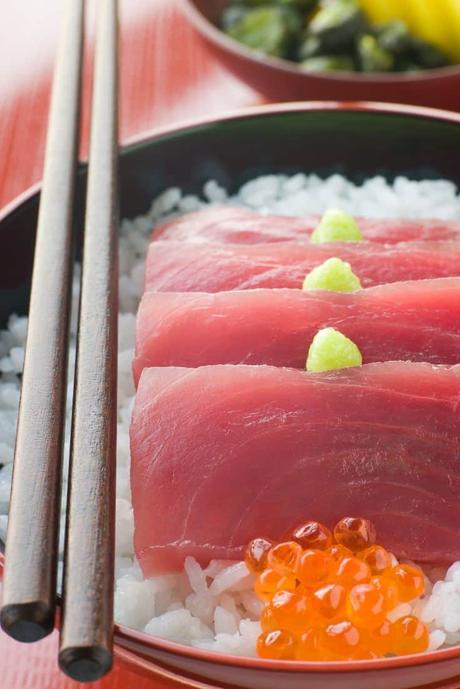
Technically, sashimi is not sushi, even though it is still categorized as sushi.
Whereas sushi is fish served with a ball of rice, which might have some extra ingredients, sashimi is just a raw fish, which is sliced and served as is.
The fish is sliced in long and rectangular slices, which are known as “hira-zukuri”.
Mostly, sashimi is served alongside soy sauce and ginger, which come as its condiments.
Nigiri
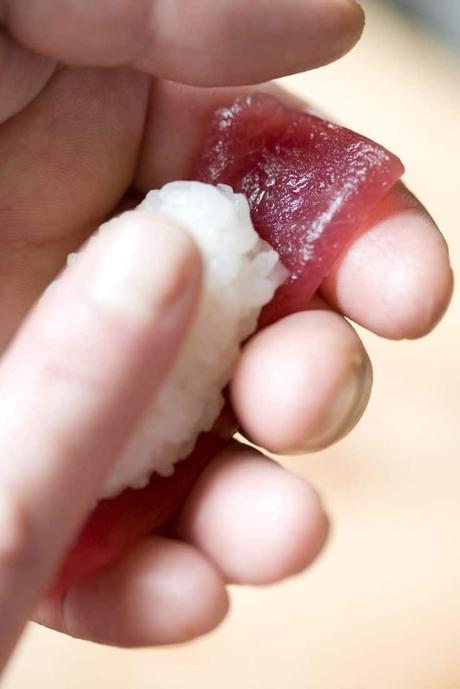
This is a type of sushi, made out of balls of sushi rice seasoned with rice vinegar, and then it is topped with a slice of raw fish.
Typically, nigiri is mostly served in two pieces, and you can eat it with your bare hands—so long as you have used the hot towel to clean them.
Chirashi
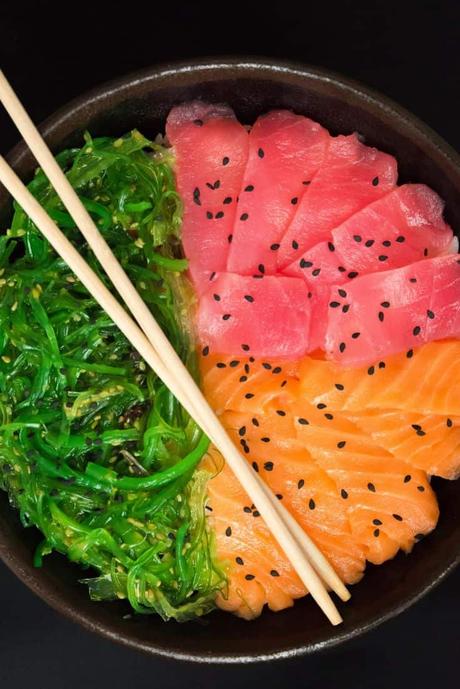
The basic Japanese definition of chirashi is “scattered.” So what is chirashi?
This is a bowl of sushi rice, which is seasoned with rice vinegar, and then topped with an assortment of raw fish and different garnishes.
The raw fish used in this dish is usually the chef’s choice.
Chirashi is simple and easy to make, and a convenient meal to eat. In Japan, different toppings are used for this dish, and it depends on the region where this delicacy is being served.
Mostly, chirashi is eaten on Doll Day or Girls Day, Hinamatsuri, a Japanese day celebrated on March 23rd.
Check out our post on the sushi knives you can use to make these yourself
Maki
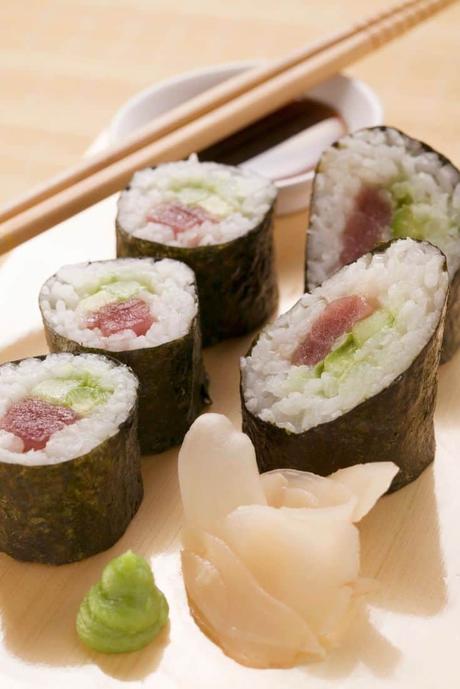
When most people think of sushi, they maki rolls come to mind first. This is cut-rolled sushi, which is traditionally made using a sheet of nori (seaweed) that’s wrapped with a layer of veggie, rice, and fish.
The sushi is then rolled with a special bamboo mat and then cut into small 6 to 8 pieces.
There are different varieties of maki sushi rolls that you can order in a traditional Japanese restaurant. These varieties range in style and size, and they include:
Futomaki
These are a bit larger sized sushi rolls, and they are stuffed with several ingredients. This type of sushi is not as the “fat” roll because it is thicker than others.
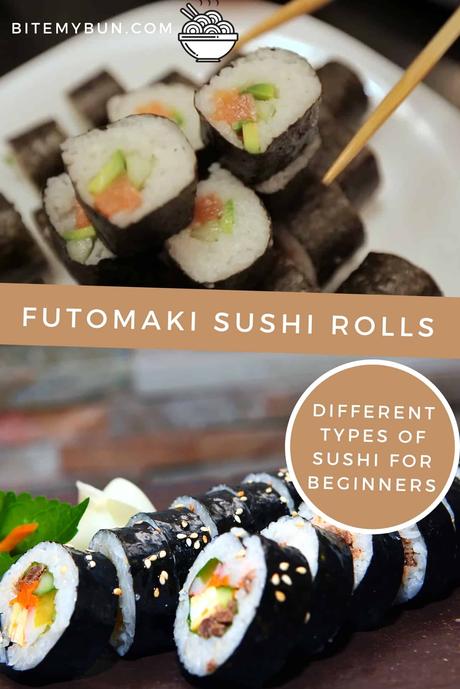
Hosomaki
These are smaller sushi rolls, and they are made into a cone shape using a sheet of seaweed (nori). However, hosomaki contains one single filling, which can be carrots, tuna, or cucumbers.

Temaki
These are hand sushi rolls, made by rolling nori sheets into cone shapes, and then filling them with fish, veggies, and rice. This type of maki sushi is mostly eaten with hands since they are too large to be eaten using chopsticks.
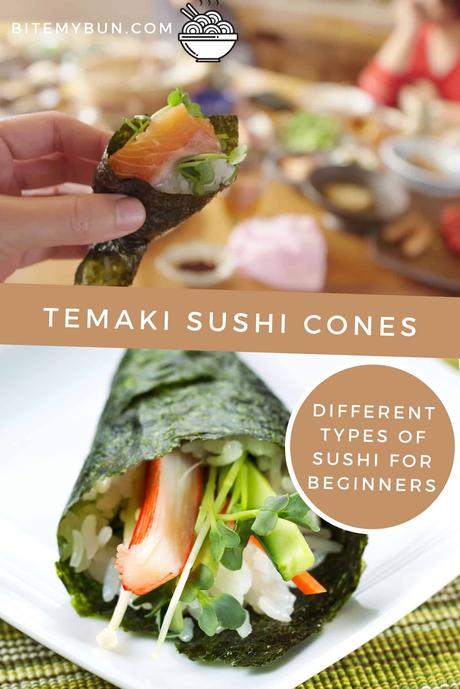
Gunkan Sushi
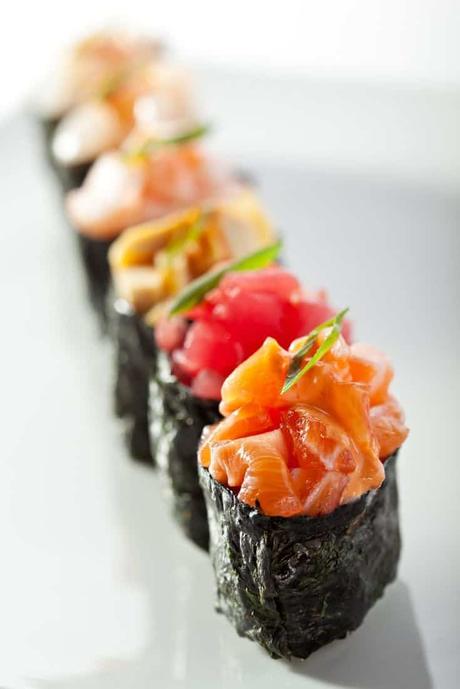
This type is like the maki sushi, only it is formed like a ship (Gunkan) with the seaweed wrapped around the side and the filling on top of the rice instead of rolled within.
Also referred to as battleship sushi, it is made by folding roasted seaweed nori) around a ball of rice seasoned with rice vinegar so that it creates a good shape that can be filled with different ingredients like salmon roe (ikura), oysters, flying fish roe (tobiko), or sea urchin roe (uni).
Inari-zushi

The inari-zushi is the most unusual form of sushi because it is deep-fried. As well, most varieties of this sushi don’t contain fish or other seafood and the rolls taste sweet.
This inari is made of tofu. It looks like a pouch and it contains deep-fried tofu that is simmered in seasoning. Most varieties simmer the tofu in mirin, dashi, soy sauce, and some sugar which gives it a sweet flavor.
Other popular varieties of this sushi include the vinegared-rice pouch and the omelet-filled inari.
Temari
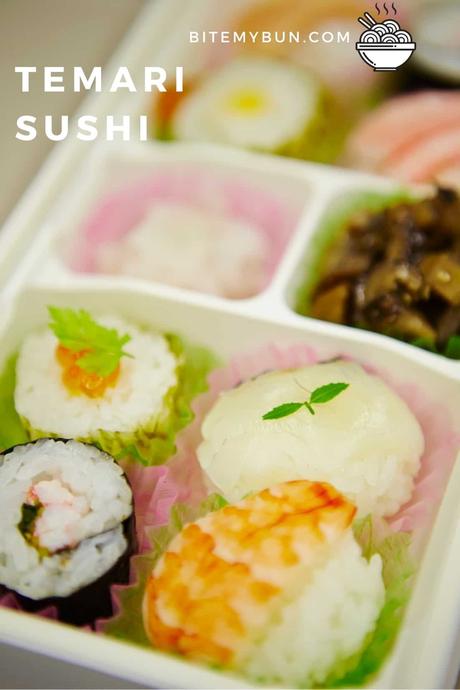
The Temari sushi is translated as ‘handball’ and that’s because this sushi has the shape of small hand-rolled balls.
It is a less popular variety of sushi and mostly made at home for celebrations. Since it’s so small, it’s great finger food.
It is a small round shaped ball of vinegared rice and topped with a layer of fish. Usually, raw salmon is used but smoked salmon and other fish can be used.
Kakinoha-Zushi
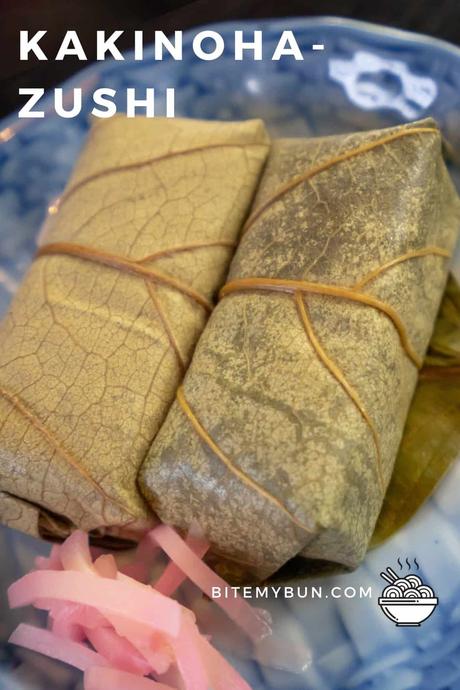
This is a very unique type of sushi popular in Japan’s Nara region. The sushi rice is pressed and wrapped in persimmon leaf (kaki).
The sushi is quite simple, it is made by placing a piece of fish on top of rice and then wrapping it like a small package.
Mackerel, salmon, prawn, and eel are all popular fillings.
Sasazushi
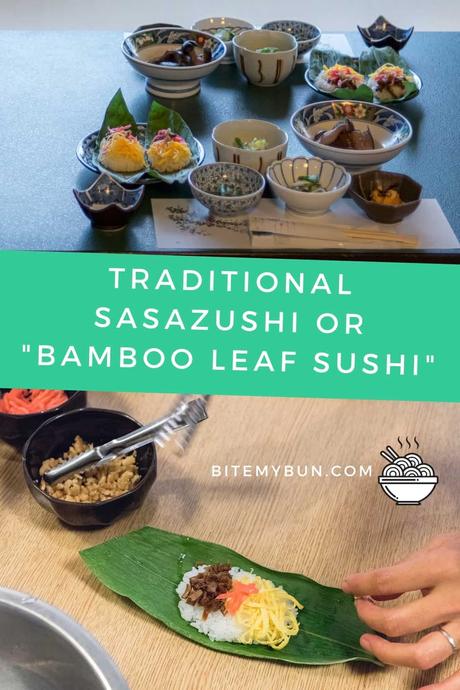
Similar to the kaki leaf sushi above, this one is a bamboo leaf sushi. It has rice and some toppings and it is wrapped in a bamboo leaf.
The most common toppings include salmon and other fish, vegetables, and even eggs. There is a sasazushi variety with walnuts, bamboo shoots, and even mugwort.
Oshizushi (Pressed Sushi)
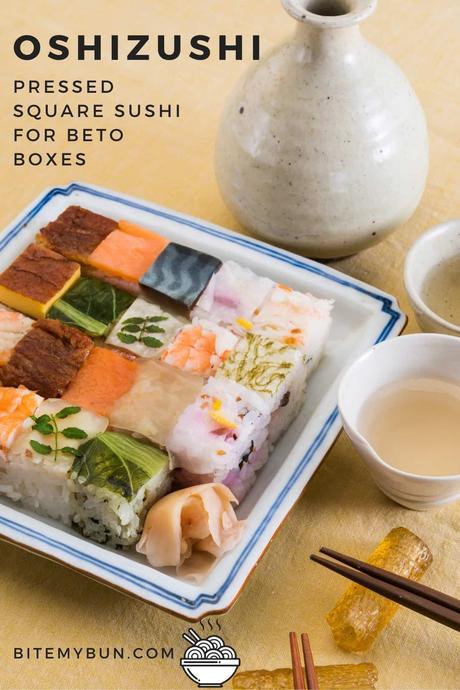
This type of pressed sushi is common in the Osaka region where it was first created. It is made by layering the sushi ingredients in a rectangular box. The individual sushi pieces look like small angular rice sandwiches.
Usually, oshizushi is served in Bento boxes and gives as a gift for special occasions.
The common ingredients include salmon, mackerel, gizzard shad, and bamboo leaves.
Narezushi and funazushi
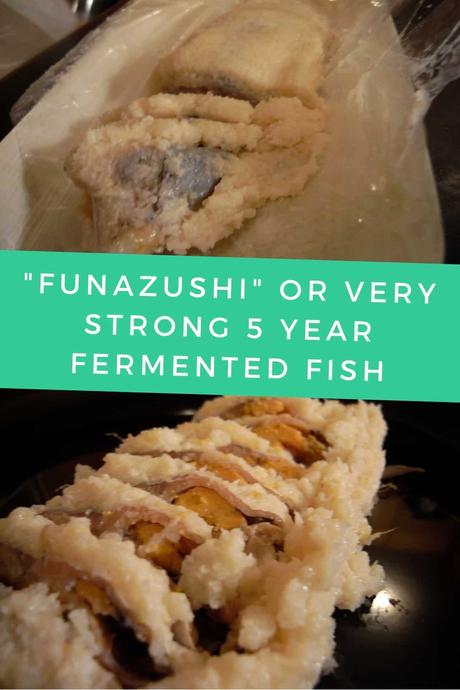
This is a text overlay image of the original work “鮒寿司” by Yasuo Kida on Flickr under CC license
The Narezushi is the oddest type of sushi on our list. Narezushi is a traditional Japanese fish dish made by preserving the fish for months in salt and rice.
It is fermented and has the typical sour and pungent flavor of fermented food. This is believed to be the original predecessor to modern sushi.
Today, there is a variety called funazushi and it takes 5 years for the fish to ferment before it is served, so it’s very expensive.
Popular types of American sushi
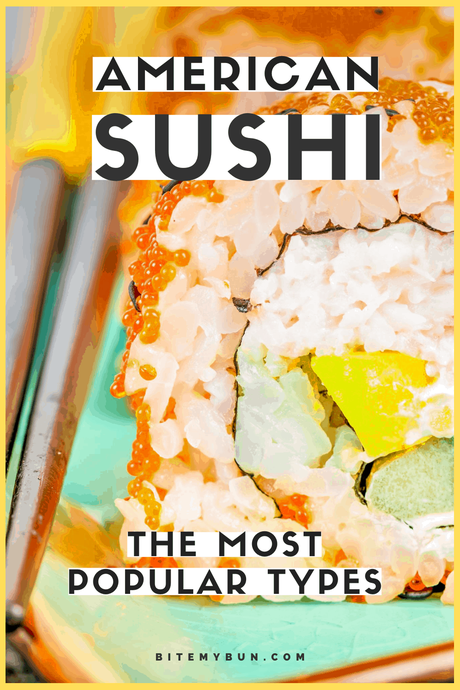
Today, there are different varieties of sushi that are served in American restaurants. These varieties are considered to be a western version of the traditional Maki sushi.
Even though these American varieties are not traditional, it does not mean that they are not delicious. The following are some of the common types of American sushi rolls, which are served in various American restaurants.
American sushi is typically a bit less healthy than traditional sushi, if you’re worried about the calorie count read this article we’ve written as well.
California roll
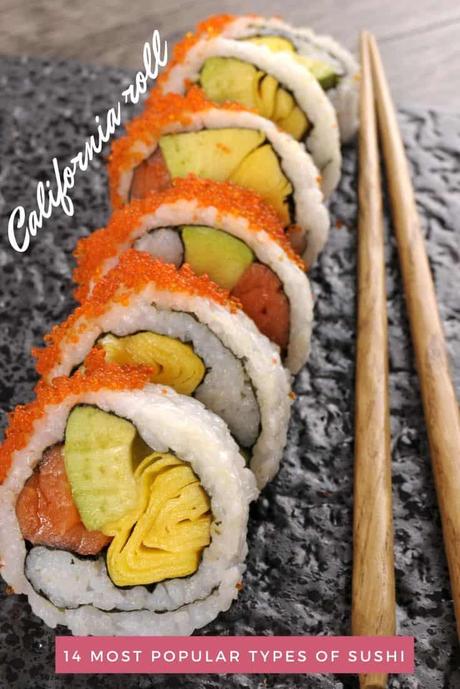
These have the appearance of an inside-out sushi roll. A California roll has the rice layer on the outside, and the sheet of seaweed (nori) is on the inside.
Mostly, this sushi roll comprises or imitation crab, avocado, cucumber, and at times flying fish roe (tobiko).
The California roll is a type of Uramaki.
The uramaki sushi is similar to maki rolls. It is made with vinegared rice, meat (usually seafood), vegetables, and seaweed.
But instead of the ingredients being wrapped in seaweed on the exterior, the filling ingredients are wrapped in Nori and the rice is on the outside. Usually, the uramaki rolls contain lots of fillings and toppings which may be raw or cooked.
Tempura roll
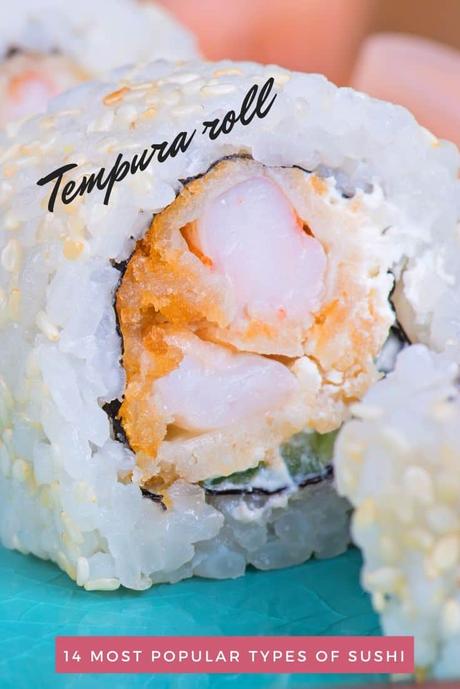
Just like California rolls, tempura rolls have the rice< on the outside.
The rice covers a nori sheet, which contains tempura fried shrimp, together with other veggies like cucumber and avocado.
Spicy tuna roll
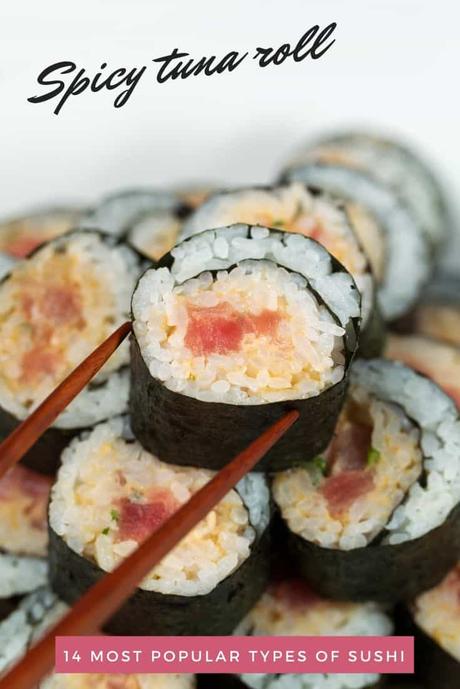
These sushi rolls have a sheet of seaweed on the outside and rice on their inside.
The sheet of nori and rice is wrapped around raw tuna, which is then mixed with seasoned and spicy mayonnaise.
Dragon roll
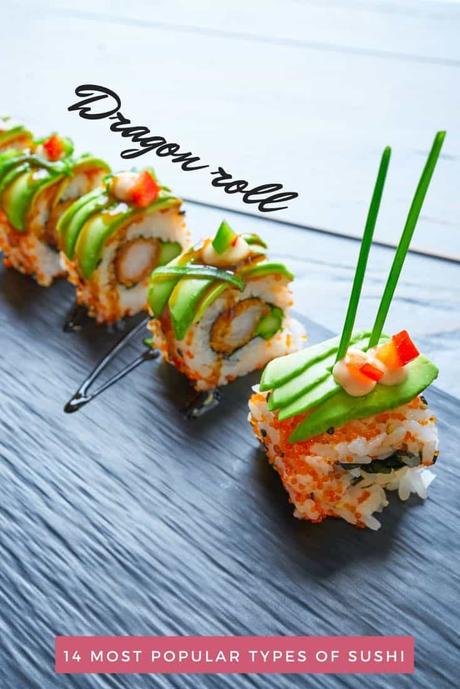
These resemble tempura rolls since they use avocado, cucumber, and shrimp tempura. The rice on the dragon rolls is on the outside, and it is mostly sprinkled with sesame seeds.
But, one thing makes these sushi rolls unique, they include thinly sliced avocado on the top of the sushi roll, together with tobiko, and then they are drizzled with spicy unagi sauce and mayonnaise.
Spider roll
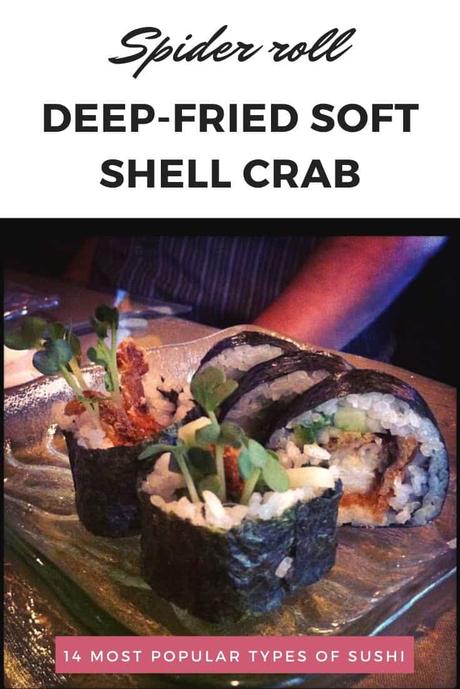
This is a text overlay image of the original work Spider Roll – Soft shell crab sushi by Loren Kerns on Flickr under cc.
These are made using deep-fried soft-shell crab, and they include different fillings like cucumber, lettuce or daikon sprouts, avocado, spicy mayonnaise, and roe.
Rainbow Roll
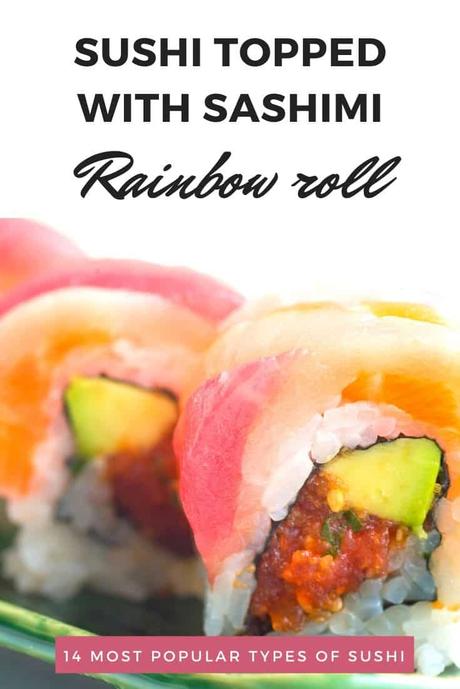
This is basically a sushi roll that has been topped with different varieties of sashimi.
Most often, the sushi roll that’s covered by sashimi is a California roll, which consists of crab and avocado.
To prepare a rainbow roll, the sushi chef first makes a California roll, and then adds the extra toppings after that to create a rainbow-like color scheme.
Philly roll

This is one of the most common sushi varieties that you will find in America.
This sushi roll comprises of salmon, cucumber, and cream cheese, even though some chefs usually add other ingredients like onion, avocado, and sesame seed.
The roll is known as Philly roll not because it’s from Philadelphia, but because chefs use Philadelphia cream cheese to make the sushi roll.
Vegetarian roll
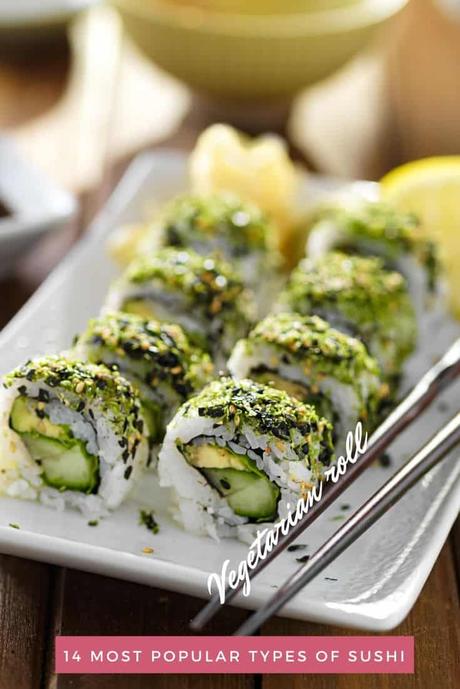
If you were worried about people who don’t like seafood and meat, then there is something for them as well.
Almost every other sushi restaurant usually offers a vegetarian sushi roll. The sushi roll contains different varieties of veggies, including cucumber and avocado.
Volcano roll
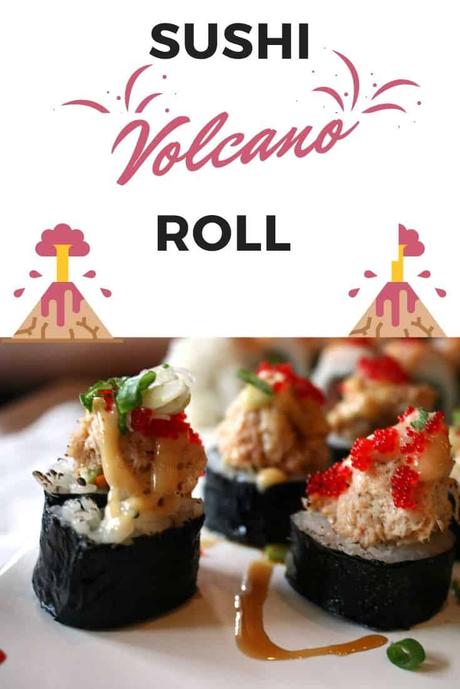
This is a text overlay image of the original work Volcano roll by Quinn Dombrowski on Flickr under cc.
The volcano roll comes with a variety of ingredients—however, all volcano rolls come with one thing in common: the toppings on these rolls make them look as if they want to explode.
That’s the reason why they were given the name “volcano roll.”
Tiger Roll
The tiger roll is a very flavorful and jam-packet sushi roll. It is vinegared rice, filled with avocado, shrimp, tempura, and fish eggs (tobiko). Also, it has a seaweed exterior and it’s popular in many North American sushi restaurants.
The tiger roll doesn’t contain raw fish, so it’s a great option if you prefer cooked ingredients. The tempura is a fried ingredient and shrimp is cooked.
Common Sides and Toppings
The three most popular sides for sushi are wasabi, soy sauce, and pickled ginger.
Wasabi is a green paste made from Japanese horseradish.
Soy sauce is salty and contributes to the sushi’s umami flavors.
Pickled ginger cleanses the palette between meals and different types of sushi. This way, you can taste the real flavors of the food.
The most common topping is fish eggs. The small orange or black balls are placed on top of the sushi. This is called tobiko or masago and it’s popular in Japan and North America.
What’s the difference between Western and Japanese sushi?
There’s no doubt that Japanese sushi is the original and the best type of sushi. However, the Western-style, inspired by a fusion of American and Eastern sushi is also very tasty.
The main difference between the two is that American sushi contains more than one ingredient. The sushi is usually in roll format and full of delicious toppings and fillings which give a bold flavor.
In the United States, the sushi rolls are packed full of meats, veggies, and fried ingredients. In Japan, sushi rolls only contain a couple of ingredients at most and they are usually not fried. When it comes to ingredients, Japanese sushi is usually not spicy and doesn’t contain avocado.
Type of rice used (brown rice vs. sushi rice)
The Japanese are very specific about the type of rice they use, and they usually use a particular variety of short-grain rice that is perfectly seasoned with sugar, rice vinegar, and salt.
Western restaurants, on the other hand, use brown rice, rather than white short-grain rice. However, the brown rice usually alters the flavor of the sushi and takes away its authenticity.
Levels of complexity
Japanese sushi is very simple, and it comprises of one type of fish, seaweed, some veggies—which are optional, as well as sushi rice soaked in rice vinegar.
The western sushi, on the other hand, they are stuffed with toppings and fillings, which comprise different varieties of fish, vegetables, and any other thing that can fit in the sushi roll.
The American version of sushi, like the rainbow roll, has three varieties of fish, which are placed on top to give the sushi some beautiful appearance.
Then the sushi has some vegetables and avocado on the inside—this can be compared to the American burgers or sandwich that can hold different things whenever possible.
The rolling technique
Traditional Japanese sushi comprises of vinegared sushi rice, raw or cooked fish, and veggies that are wrapped in a nori sheet (seaweed) that is toasted.
American sushi, on the other hand, is rolled inside out, where the nori is on the inside, and the sushi rice on the outside.
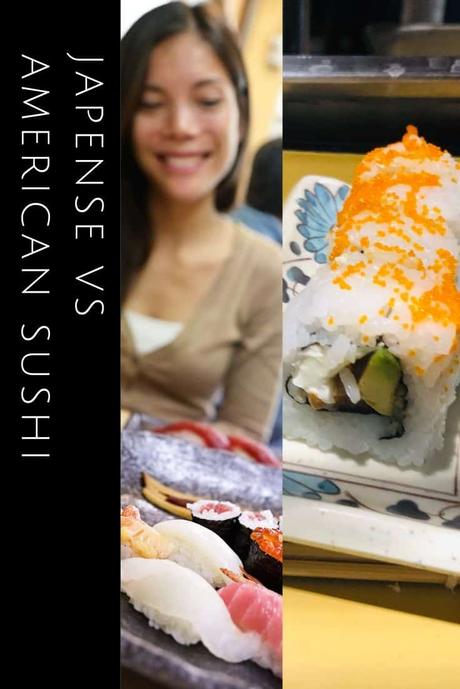
Size
Traditional Japanese sushi should be eaten with only one bite. One sushi roll is mostly cut into six small pieces, which are ideal to be eaten in just one bite.
American sushi roll, on the other hand, is a bit fat, and the roll can produce 8 or more pieces, which cannot be eaten in one bite.
Also read: these rice cookers will make your cooking so much easier
How can you choose the best sushi restaurant?
Choosing the best sushi restaurant is a challenge for many people. However, there are some guidelines that you can follow, which can assist you to have the best sushi experience.
These guidelines include:
- There is always one general rule—always eat in restaurants that have a good sushi reputation. It’s important to understand that the price doesn’t mean that that you will get quality sushi.
- Some restaurants have the “all you can eat” sushi-style, which is a bit tempting, but it doesn’t mean that you will get quality sushi.
- When you notice that the majority of the items in the restaurant’s menu are cooked, instead of raw, then that might be an indication that the fish uses is either of poor quality or old.
- Always check whether the rice used is cold or at room temperature—never eat sushi made with cold rice.
- Don’t eat sushi with soggy seaweed. If the sushi rolls are truly fresh, then the seaweed will be crispy, as well as have a nice and toasty flavor.
- The restaurant’s display case, where the fish are placed should always look organized and pristine—avoid eating in restaurants with messy display cases.
- The server should have a good knowledge of the menu and should be able to answer all your questions without struggling.
- If the restaurant smells fishy, leave immediately. It’s like when you get a fish from the market or store, if that restaurant has a funny smell, then there is a possibility that you will not eat fresh sushi, or the restaurant is not cleaned well.
What’s the best way to order sushi?
Traditional Japanese sushi restaurants have a basic etiquette that everyone should follow when ordering sushi. Western-style restaurants, on the other hand, you can just order without observing any etiquette. However, there are certain rules that you should follow in both settings.
How to choose the sushi you want to order
- In the event you are confused about the type of sushi you want to order, it’s always a good idea to ask for help from the server. Never feel ashamed to ask any question. Are you unfamiliar with things? Ask for help! Do you want to know what’s best? Ask too! The server will be willing to assist you to choose the best sushi for the ultimate sushi experience. If you are dining in a good restaurant, the server will have the knowledge to assist you whenever you are stuck.
- Leave everything to the sushi chef. In Japanese, this is known as omakase dining style, where you give your chef the power to choose whatever he wants to serve. So, is this a good idea? Yes, and you should always follow it since the chef will always serve the best deal for the day. However, you shouldn’t be afraid of alerting the chef of any preferences or food allergies before allowing him to take control.
- It’s always a good idea to order at most two items each time rather than ordering everything at once. With this, in case you get something that doesn’t impress you, you can alter your order the next time. One way to have a good sushi experience is to mix different varieties of sushi.
- Sit at the sushi bar—if you can. Even though not everyone loves sitting at the sushi bar, it’s one of the best places to sit in a sushi restaurant. The sushi bar allows you to see what the chef is doing. You can observe the artistry and skills that are used in preparing your sushi. In addition, it gives you the opportunity to communicate directly with your chef. In case you have questions, or are looking for recommendations, ask the chef.
How to eat sushi correctly
- You can use chopsticks when enjoying your sushi, but you don’t have to. That’s just something we’ve introduced in the West. It is never wrong to use your hands. Particularly when eating hand rolls as you can just touch the nori on the outside. If you are picking sushi from a shared plate, make sure that you use the back end of the chopsticks when picking the roll apart, and never eat sashimi with your hands. That’s a no-no everywhere.
- Nigiri should be eaten with chopsticks as there is no nori to pick it up. When dipping it in soy sauce, hold it sideways and then turn it slightly while dipping only the fish part in the soy. Don’t dip too much and never shake off the soy sauce but quickly put it in your mouth to eat.
- Whenever you are not using the chopsticks, place them on the chopstick holder on the table.
- Every piece of sushi has to be eaten in one bite. Although it might be a mouthful, especially the larger American types of sushi with rice on the outside taking several bites is not the way to eat it and can make the pieces fall onto the table, and you don’t want that to happen since it is considered to be rude by the Japanese.
How to Eat the Toppings and Sauces
- You should eat the pickled ginger (gari) in between the servings as it assists in good digestion of the food, and also cleanses your palate. You should never eat the ginger together with the sushi, or dip in the soy sauce.
- If you want to dip your sushi in the soy sauce, just dip the fish part of the sushi. You should never dip the rice in the soy sauce, especially with a nigiri piece or American sushi with rice on the outside. The rice can become soggy and break when it absorbs the sauce, but more importantly, dipping it in soy sauce can ruin the perfectly seasoned flavor of the rice. When dipping a maki roll with nori on the outside you can just very lightly dip one side of the piece in the soy sauce. When they serve sushi with a sauce, like spicy mayonnaise or unagi sauce, then the soy sauce is not necessary anymore.
- It has become a common thing for diners to add wasabi, either to the fish or by mixing it to the soy sauce. This is a common practice in American restaurants but you should never mix the wasabi in the soy sauce. In traditional restaurants, sushi chefs will have prepared the sushi rolls with the wasabi already inside of them. Alternatively, it can be under the fish on top of the nigiri. Most American restaurants will probably not have the wasabi already in them since not all Americans like the taste and those who do are accustomed to adding it to their sauce. If you want to use wasabi, add a little bit on top.
Sushi etiquette
- Most Japanese sushi restaurants will give you a hot towel before you start dining. The purpose of the towel is to clean your hands.
- When you decide to sit at the sushi bar, order your appetizers, and drink from the server. Your chef is responsible for handling all your sushi orders.
- Never order wasabi and soy sauce if they are not offered. It’s important to note that sushi should be enjoyed, not soaked under other sauces. In a traditional sushi restaurant, the chef makes sure that he adds the required amount of seasoning needed to make the fish stand out. If that’s the case, never add anything to your sushi—just enjoy it without any additional sauces.
- In case the chef provided soy sauce, pour it into the bowl or dish offered for the sauce.
- Never ask the chef whether the fish is fresh—this is considered to be rude. Rather, ask the chef what he recommends for that day.
- When dining at a traditional sushi restaurant, always start with the sashimi, and then sushi.
- Always eat the pickled ginger as a palate cleanser. Take a small bite of the ginger in between sushi bites—never eat the ginger together with the sushi.
- When you order nigiri, make sure that you eat the rice that accompanies it. Never leave the rice balls behind. If you needed sashimi, then go ahead and order it, rather than leaving the rice balls behind.
- Every piece of sushi should be eaten in one bite. Taking several bites is considered to be poor etiquette.
Although this might look intimidating the first time, understanding your sushi, as well as the information and etiquette that accompanies it can assist you to have an amazing and memorable sushi experience every time.
Sushi FAQs
What is the most popular type of sushi?
It depends if you are asking about Western or Japanese sushi.
In America, the most popular types of sushi are:
- California Roll
- Dragon Roll
- Spicy Tuna Roll
- Rainbow Roll
- Tiger Roll
In Japan, the most popular sushi are:
- Makizushi
- Nigiri
- Sashimi
Can you eat sushi every day?
Eating sushi every day is not very healthy, especially if it contains raw fish.
It’s healthiest to consume sushi only once in a while, or on a weekly basis. When consumed in moderation, it benefits your health because it is high in protein, low in fat, and contains Omega-3 fatty acids.
Omega-3 fatty acids can help reduce cholesterol levels in the body. As well, it lowers the risk of heart disease.
But best of all, most sushi is low in calories, so even people on a diet can enjoy this tasty food.
Which sushi is healthiest?
The main culprit when it comes to making sushi unhealthy is rice. But, there are many healthy sushi options, and here are some of them.
- Sashimi (contains no rice)
- Tuna Rolls
- Salmon Avocado Rolls (contain healthy fats)
- Mackerel Roll
- Naruto Rolls
- Cucumber Roll (only one ingredient on rice)
- Avocado Roll with Brown Rice
If you make sushi at home, you can substitute white rice with brown rice to make it healthier and lower in calories.
Is sushi good for losing weight?
Like we mentioned above, healthy is generally healthy food and low in calories. Japanese cuisine is very healthy and it helps you lose weight because it is low in calories and incorporates low-fat ingredients. Most sushi is not deep-fried or covered in sauce, therefore it’s not bad for your diet. Also, most sushi varieties don’t contain added fats.
How much sushi is in a roll?
Sushi comes in a big roll. Each roll is cut up into six or eight bite-sized pieces.
Why is sushi expensive?
Sushi is expensive because most of it is made with expensive ingredients such as seafood and seaweed. These ingredients need to be fresh and high-quality, so they are costlier than processed foods. For example, sushi-grade fish such as tuna is expensive and can cost up to a hundred dollars per pound, depending on the type.
Sushi is also very labor-intensive to prepare. It required quite a lot of work to make the rolls.
Bottom Line
When you visit Japan, make sure that you try out as many sushi varieties as possible.
Today, there is something that you will notice when you visit Japan, sushi is found almost at every other corner.
You’ll find sushi on the supermarket shelves and in convenience stores. Then there are the home-made sushi rolls, not to forget sanding sushi bars, upmarket sushi restaurants, and conveyor belt sushi restaurants.
Some of these sushi eateries have reservation waiting lists that are booked several months in advance.
If you want to have the best Japanese sushi experience, make sure that you try out sushi whenever and wherever you find it.
Some of these Japanese sushi varieties are hard to find in any other part of the world. Take into consideration that the type of local rice, the fresh seasonings, and veggies used, and the attention to detail of the sushi chefs can only be found in Japan.
Just make sure that your visit to japan gets complemented by having a sushi experience.
Want to know more about making sushi? Then this guide for beginners is for you.
